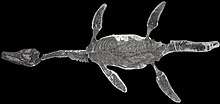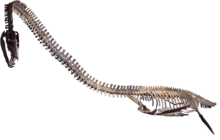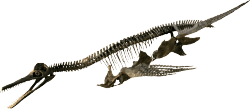Aristonectes
Aristonectes (meaning 'best swimmer') is an extinct genus of plesiosaur from the Late Cretaceous Paso del Sapo Formation of what is now Argentina, the Quiriquina Formation of Chile and the Lopez de Bertodano Formation of Antarctica. The type species is Aristonectes parvidens, first named by Cabrera in 1941.
| Aristonectes | |
|---|---|
 | |
| Reconstruction of Aristonectes parvidens | |
| Scientific classification | |
| Kingdom: | Animalia |
| Phylum: | Chordata |
| Class: | Reptilia |
| Superorder: | †Sauropterygia |
| Order: | †Plesiosauria |
| Family: | †Elasmosauridae |
| Clade: | †Aristonectinae |
| Genus: | †Aristonectes Cabrera 1941 |
| Species | |
| |
| Synonyms | |
|
Turneria Chatterjee & Small 1989 | |
Classification

Aristonectes was classified variously since its original 1941 description, but a 2003 review of plesiosaurs from Patagonia conducted by Gasparini et al. (2003) found that Aristonectes was most closely related to elasmosaurid plesiosaurs like Elasmosaurus. The authors also considered Morturneria a junior synonym of Aristonectes because the former's holotype has unfused neural arches of the vertebrae indicative of juvenile status.[1] Subsequent study, however, revalidated Morturneria based on non-ontogenetic differences from Aristonectes.[2]
Aristonectes was placed within its own family, Aristonectidae, along with Tatenectes, Kaiwhekea, and Kimmerosaurus, by O'Keefe and Street (2009), as sister family of the polycotylid cryptoclidoids. However, subsequent studies (Otero et al., 2014)[3][4] returned Aristonectes to Elasmosauridae, recovering the genus as a derived elasmosaurid and therefore relegating Aristonectidae to a subfamily of Elasmosauridae, as Aristonectinae.
References
- Gasparini, Z., Bardet, N., Martin, J.E. and Fernandez, M.S. (2003) "The elasmosaurid plesiosaur Aristonectes Cabreta from the Latest Cretaceous of South America and Antarctica". Journal of Vertebrate Paleontology 23(1): 104-115.
- O'Keefe, F., Otero, R., Soto-Acuña, S., O'gorman, J., Godfrey, S., Chatterjee, S. 2017. Cranial anatomy of Morturneria seymourensis from Antarctica, and the evolution of filter feeding in plesiosaurs of the Austral Late Cretaceous. Journal of Vertebrate Paleontology. doi: 10.1080/02724634.2017.1347570
- Otero, R. A., Soto-Acuña, S. and Rubilar-Rogers, D. 2012. A postcranial skeleton of an elasmosaurid plesiosaur from the Maastrichtian of central Chile, with comments on the affinities of Late Cretaceous plesiosauroids from the Weddellian Biogeographic Province. Cretaceous Research, 37: 89–99.
- Otero et al. (2014), Aristonectes quiriquinensis, sp. nov., a new highly derived elasmosaurid from the upper Maastrichtian of central Chile
External links
| Wikimedia Commons has media related to Aristonectes. |




